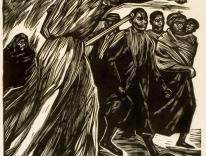Editor’s Note: The September issue of Commonweal featured a symposium titled “Abortion after Dobbs.” The magazine has been publishing a series of articles and essays that continue the conversation begun in the symposium. This is the third in that series.
The American pro-life movement was born in the wake of Roe v. Wade. And it may well die in the wake of Dobbs v. Jackson—die and yet possibly be reborn, break and be reforged. The fight against abortion is still dangerously fragile, even in the joy that followed the Dobbs decision this past June. The wish to protect vulnerable life may, if all goes poorly, fade into a glum and hopeless acceptance of political compromise, akin to Europe’s, in which the social will to ban abortion and state-licensed euthanasia simply does not exist.
And yet, at its most promising, a post-Dobbs pro-life movement offers an opportunity to bridge America’s horrendous current political divisions, building alliances that once seemed impossible. A new care for the weakest among us offers an opening for rethinking old arguments that had no purchase under the legal regime of Roe. And a revived will to welcome new life in the womb, and cherish life after birth, offers an occasion to develop a moral vocabulary that does not try to squeeze every ethical issue into the narrow mold of natural rights.
To understand the changes in America after the Supreme Court’s Dobbs v. Jackson decision this summer, we have to remember exactly what Roe v. Wade did in 1973 (together with its essential affirmation in Planned Parenthood v. Casey in 1992). The justices declared abortion to be a constitutional right, a fundamental and inalienable moral element in human existence, of a weight equal to such other rights as freedom of speech and freedom of assembly.
However much abortion would seem a political issue over the next nearly fifty years, Roe actually lifted the reality of abortion out of the political realm. Back in the late 1990s, I spent a day with a pro-life Supreme Court justice who had agreed to discuss the topic with a small group of public intellectuals. And he was, all in all, quite phlegmatic about the pro-life cause, which in those days seemed close to its nadir. You lose a vote, he suggested, and you steel yourself to come back the next time to argue it all over again. That’s the nature of such things in the public square. What he didn’t seem to grasp is that he was speaking of a public square with only nine people in it. For the rest of America, the question of abortion was in the political realm only at several removes: electing senators and a president who would put pro-life justices on the court, amidst all the other policy issues that our two-party system crams into a single mark on a ballot.
Under these conditions, it’s not surprising that the pro-life cause would eventually become identified primarily with a single party. In the first few years after Roe, there were prominent Democrats with national ambitions, from Jesse Jackson to Dick Gephardt, who loudly proclaimed their opposition to abortion. In the coming decades, however, the ledge for pro-life Democrats would narrow considerably. In 2004, Dennis Kucinich, the once–boy mayor of Cleveland, renounced his longtime liberal pro-life position, the only thing that had distinguished him from any other middle-of-the-pack Democratic candidate, in order to raise money for a presidential run. He was hardly alone. In 2000, I had a series of discussions with a young Democratic congressman from the Midwest who thought that perhaps opposition to cloning was a path to national prominence. But when I suggested that he would be hard pressed to make a simple soundbite-style argument against cloning that didn’t implicate abortion, he abandoned the issue, telling me that abortion was the untouchable rail for Democrats seeking national office. In 2010, Bart Stupak, the congressman from Michigan’s first district, led a small pro-life Democratic bloc in the House of Representatives that was at least sufficiently large that the Democratic leadership had to treat with him to pass Obamacare. By 2021, Henry Cuellar, from Texas’s twenty-eighth district, was the only self-declared pro-life Democrat remaining in the House.
So too, in the first few years after Roe, there were prominent Republicans, from Nelson Rockefeller to Barry Goldwater, who were in favor of legalized abortion. In 1967, Ronald Reagan signed an act, as governor of California, that would allow legal abortions in the state to jump from a few hundred to over a hundred thousand. Even among the conservative religious, the identification with opposition to abortion had not yet formed. The Southern Baptist Convention adopted a 1971 resolution supporting the legalization of abortion, and after Roe was issued, praised the court for its decision. In the late 1960s, the then-radical (and then-Protestant) Richard John Neuhaus won a Catholic Press Award for a prescient article warning that the American political scene was increasingly planting the pro-life flag on the wrong side of the liberal/conservative divide. It ought to be those heartless country-club Republicans who were in favor of abortion to erase the poor—just as it ought to be the compassionate Democrats who wanted to expand the community of care to include the unborn. (In the end, the political reality of how to influence the abortion debate would be a major factor in Neuhuas’s turn to conservatism. The time comes, as Midge Decter once quipped, when you have to join the side you’re on.)
Through it all, there was plenty of hypocrisy, showboating, and crude political calculation on both sides. The sexual revolution (and the incalculable extent to which it relied on abortion) contributed a large share, as did the sense among anxious conservatives of a world come adrift. Like the gold standard in 1896, abortion in the 1990s had become a symbol and a synecdoche for far too much to be entirely intelligible as a single issue in American politics. The clearest way to understand the cloning and embryonic stem-cell debates of the late 1990s, an odd issue to be central in the 2000 presidential campaign, is as a stand-in for abortion.
The main reason abortion politics was so strange, however, was the Roe definition of abortion as a right, which precluded resolution or even much consequential compromise in the course of ordinary politics. The pro-life movement—to which I belonged, and for which I fought, over the course of decades—operated under the Roe legal regime. In fact, Roe essentially created the American pro-life movement, and it survived and grew in the United States in ways that it did not in other countries precisely because it wasn’t entirely political but an argument about moral fundamentals and interpretation of the Constitution.
From 1973 through to the fifteen-week limitation in the Mississippi law that led to Dobbs in 2022, commentators often pointed out that Roe and then Casey legalized abortion far later in pregnancy than nearly every other (non-Communist) country did. But the real radicalism of Roe was the definition of abortion as a right. Rights have a kind of gravitational weight toward which other rights must lean. In physics, teachers sometimes illustrate gravity by placing steel balls on a rubber sheet, warping the sheet into wells. In the same way, abortion weighed heavily on constitutional law. Abortion-clinic protection laws, for example, tugged at laws protecting free speech, protest, and assembly, limiting the expanded 1960s understandings of those rights.
In this setting, the pro-life movement became a strange amalgam of legal commentary, emotional fellow-feeling, and political action that gave us little more than support for Republicans in the sometimes-vain hope that they would seat pro-life Supreme Court justices who would not become pro-choice once they were on the bench. And so too, in the way of a warped mirror, the Democrats. Their last three presidents, Clinton, Obama, and Biden, all campaigned as triangulators, centrists, and healers of political divisions, but all three governed as absolutists on abortion.
And then came the 2016 election, in which the odd set of political issues symbolized by abortion overwhelmed the symbol and broke free. Trump vs. Clinton was, in some sense, the first election since 1976 that wasn’t about abortion. Who could trust Trump on abortion—a man whose first response to a question about a Supreme Court nominee was to suggest his sister, a pro-abortion judge? A man who couldn’t be bothered to learn the arguments and rhetoric that public-intellectual pro-lifers had spent four decades developing, speaking instead of jailing women and, in early primary debates, praising Planned Parenthood? “Forget walking the walk,” I wrote at the time. “Donald Trump cannot even talk the talk.” Hillary Clinton occasionally gestured toward abortion in 2016, but it was more by way of shoring up her base than really raising it as a campaign issue.
Then Trump won the presidency and nominated three pro-life justices to the Supreme Court. And so we got Dobbs, which said abortion was not a right and returned the procedure to where it had been before Roe: a state legislative issue on which various states might disagree. Eleven states immediately restored their pre-Roe bans on abortion or began applying “trigger laws” (post-Roe legislation passed to enact the banning of abortion, to be triggered by the overturning of Roe). Other states, notably California and New York, passed new legislation allowing abortions at any point in pregnancy, beyond even the permissive limits of pre-Dobbs jurisprudence. Soon, about ten states will probably have a total ban on abortion except in cases of rape, incest, and physical threat to the life of the mother (as with ectopic pregnancies); about ten other states will have nearly no restrictions on abortion; and the remaining thirty states will have restrictions somewhere in between.
So where do we go from here? If abortion had been an issue in normal legislative battles over the past forty-nine years, we would have ended up with some compromise that varied from state to state but essentially allowed legal abortion in the United States somewhere around twelve to fifteen weeks, with exceptions. And there would be no serious social will to re-legislate or re-debate the issue at this late point.
That may still be where America ends up after Dobbs. But we did have decades of Roe, and a serious pro-life movement may not disappear now that the battle has shifted. It’s just that it will have to fight different fights, build with new kinds of incrementalism, and find new rhetoric with which to persuade.
For years, a standard type of pro-life essay was an evisceration of the constitutional reasoning in Roe and Casey. I would groan when I saw yet another essay on the topic from Hadley Arkes, yet another law-review article by Richard W. Garnett, yet another swipe from Mary Ann Glendon, and then more of the same from such younger legal analysts as Sherif Girgis. But I was wrong, and they were right. The cumulative effect of all that work over decades could be discerned during the oral arguments when Dobbs came to the Supreme Court. For older veterans of the pro-life cause, it was astonishing to see that neither of the lawyers opposed to revisiting abortion law—Julie Rikelman, representing the Jackson abortion clinic that had brought the case against Mississippi, and Elizabeth Prelogar, the solicitor general, appearing for the Biden administration—took much time to defend the actual arguments of Roe or even Casey as constitutional law. Their arguments were nearly entirely about stare decisis, precedent, and Americans’ reliance on long-settled law. Roe was sloppy constitutional reasoning, they seemed to agree, but legalized abortion was good policy, and it had been treated as a basic right for forty-nine years, with over two generations of women planning their reproductive future on the basis of that right.
In this sense, the law professors are the heroes of the Dobbs decision. They kept the pot bubbling, and they helped such entities as the Federalist Society keep the issue central to their recommendations of judges to Republican presidents. Constitutional reasoning, however, no longer occupies much space in the pro-life fight (unless you think, as I do, that Roe was doubly wrong: first in taking the issue away from the states, and then, if it must be taken from the states and declared a right, in not finding the right to be the right of the unborn to live). After Dobbs, the issue has become social and political, in the much more ordinary senses of those words.
Yes, the first reactions to Dobbs still came from the old Roe world. There was new violence, with such groups as Jane’s Revenge vandalizing more than sixty crisis-pregnancy centers and pro-life offices around the country. There were despicable attacks on at least thirty-eight churches, including an abortion-supporting Methodist church near Washington D.C.—in a blind application of the idea that arguments against abortion are all religiously motivated and therefore all Christian churches are somehow to blame. And the sides remained identified with their dominant parties. Many serious Democratic strategists calculated that the abortion issue would outweigh voters’ economic worries in the 2022 midterms, while several Republican analysts urged candidates to remind voters that their votes had led to Dobbs.
Once the dust settles, however, ending abortion becomes a matter of persuasion, state by state. This will require some long-term thinking, with incrementalism an acceptable tactic. Think, for example, of what Michigan pro-lifers might have done if they had perceived the post-Dobbs landscape more clearly. They could have passed a fifteen-week ban on abortion (which polls showed the state’s voters generally approve of) and thereby forced the governor, a hardline supporter of abortion, to veto it—making clear where the radical supporters of abortion actually stand. But the pro-lifers refused to do this, in the name of abortion purity, and so Michigan has now passed a state-constitutional amendment that will legalize nearly all abortions.
We need to abandon the kind of purity that led Judie Brown of the American Life League, for example, to condemn any incrementalism among her fellow pro-lifers in the 1990s. We must take whatever partially persuaded people and fellow travelers we can, and we must use small gains to build larger gains in the political process. Pro-life allies need to come from both the Left and the Right—with neither party able to assume it has corralled pro-life voters, and both parties forced to make concessions to the cause.
Along the way, it will be worth revisiting rhetorical and intellectual strategies that were set aside during the years of Roe. The “seamless garment” of life issues, for example—Cardinal Bernardin’s efforts to propose what he called a “consistent life ethic”—looked to many pro-lifers back in the 1980s and ’90s like nothing more than a downplaying of abortion, as though its proponents were saying, “Oh, yes, sure, abortion. But first nuclear weapons, the death penalty, poverty programs, the environment, and dozens of other more important problems.” With more than 50 million lives lost to abortion in America from 1973 to 2022, attempts to equate it with other issues appeared a disingenuous tactic of those who weren’t actually much bothered by abortion.
Now, however, may be a time to revisit the seamless garment—since what is necessary is not training a new generation of pro-life lawyers but expanding the effectiveness of pro-life rhetoric. The radical edges of the cultural Left are probably not persuadable. And the radical edges of the Right don’t have a coherent view on abortion, as far as I can tell. But the devices of speaking of life in general, of saying that care for the vulnerable begins in the womb and extends through to natural death, may bring along the sensible middle in these days after the demise of the Roe regime. Certainly, it’s worth a try.
Most of all, we must refuse the language of “abortion rights,” with its euphemisms “reproductive rights,” “women’s health rights,” and all the rest. For fifty years, abortion forced on the nation a falsity of language from which we have not recovered. “Embryo,” “blastocyst,” and even—the coldest of terms—“product of conception” may have scientific uses, but they are all names given to what every human being is at that moment of development. And they were deployed in the Roe years as bait-and-switch gotchas: the developing entity at that stage, we were told, is properly called an embryo, and thus to call it an unborn baby isn’t properly scientific. And that somehow meant it isn’t an unborn baby.
Every ultrasound shows expectant parents that the unborn entity is human, with needs and vulnerabilities. The unborn child, in fact, is uniquely needy and uniquely vulnerable. The moral vocabulary we need for persuasion is not the language of rights. The supporters of legalized abortion tried that path for forty-nine years, and it ended up giving America the largest pro-life movement in the Western world. The language we need now is the language of love and care. We must teach our fellow citizens to love the weak and the fragile—and the weaker and more fragile they are, the more we must love them, welcome them into life, and care for them along the way.


